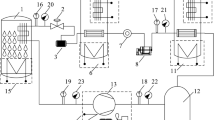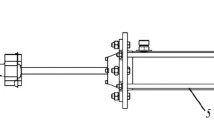Abstract
A whole-process simulation platform is established for linear compressor to analyze the performance characteristics on different piston displacement conditions from small oscillation without pumping till to rushing out of the top dead center (TDC). The measuring methods of the related parameters in the model are presented and the values of these parameters are obtained from an actual test. The simulated results agreed well with the experimental results under the same working conditions. The errors of the effective voltage, the effective current, the compression efficiency and the phase angle between the current and the displacement were within ±6.9%, ±8.5%, ±6.2% and ±13.4%, respectively. Based on this simulation platform, the performance characteristic around the TDC of the linear compressor on different working conditions is analyzed. The performance comparison on 60 Hz shows that the compression efficiency near to the TDC on 0.7 MPa is higher than that on 0.5 MPa because the phase angle α under that condition is around 90°, but the operation reliability on 0.7 MPa is worse than that on 0.5 MPa because the jump phenomenon happens when the piston displacement goes near to the TDC. The jump phenomenon results in unstable operation as the piston displacement jumps from the position before the TDC to the position after the TDC. According to the simulation on different power frequency, two important performance characteristics are inferred. One is that there is an inflection point in the curve of the phase angle α versus the displacement at the TDC. This characteristic is a good choice for the TDC detection. The other is that the jump phenomenon is prone to happening when there exist different displacement responses on the same voltage value, becoming inconspicuous when the power frequency is decreased and disappearing when the power frequency is increased. Based on this characteristic, the jump phenomenon can be avoided through suitable system configuration and frequency adjustment.
Similar content being viewed by others
References
N. R. Walt and R. Unger, The simulation and design of a high efficiency, lubricant free, linear compressor for a domestic refrigerator, Proceedings of International Appliance Technology Conference at Purdue, Purdue University (1992).
R. Unger, Development and testing of a linear compressor sized for the european market, Proceedings of International Appliance Technology Conference at Purdue, Purdue University (1999).
A. Heydari, Miniature vapor compression refrigeration systems for active cooling, Inter Society Conference on Thermal Phenomena (2001) 371–378.
F. Possamai, D. E. B. L., A. Zummermann and R. Mongia, Miniature vapor compression system, Proceedings of the International Compressor Engineering Conference at Purdue, Purdue University (2008).
H. Lee, S. Jeong, C. W. Lee and H. K. Lee, Linear compressor for air-conditioner, Proceedings of the International Compressor Engineering Conference at Purdue, Purdue University (2004).
C. R. Bradshaw, E. A. Groll and S. V. Garimella, A comprehensive model of a miniature-scale linear compressor for electronics cooling, International Journal of Refrigeration, 34 (2011) 63–73.
C. R. Bradshaw, E. A. Groll and S. V. Garimella, A sensitivity analysis of a miniature-scale linear compressor for electronics cooling, Proceedings of International Appliance Technology Conference at Purdue, Purdue University (2012).
E. Pollak et al., Mathematical modle of an electrodynamic oscillating refrigeration compressor, Proceedings of International compressor Engineering Conference at Purdue, Purdue University (1990).
G. Choe and K. Kim, Analysis of nonlinear dynamics in a linear compressor, International Journal Series C of Japan Society of Mechanical Engineers, 43(3) (2000) 545–552.
G. Choe and K. Kim, Theoretical and experimental analysis of nonlinear dynamics in a linear compressor, Journal of Vibration and Acoustics, ASME (2002) 124.
M. Lamantia, A. Contarini and S. Giovanni, Numerical and experimental analysis of a linear compressor, Proceedings of International compressor Engineering Conference at Purdue, Purdue University (2002).
H. Kim et al., An experimental and numerical study on dynamic characteristic of linear compressor in refrigeration system, International journal of refrigeration, 32 (2009) 1536–1542.
J. Kim et al., An experimental and numerical study on an inherent capacity modulated linear compressor for home refrigeratiors, International Journal of Refrigeration, 34 (2011) 1415–1423.
H. Zou, L. Zhang, G. Peng and C. Tian, Experimental investigation and performance analysis of a dual-cylinder opposed linear compressor, Journal of Mechanical Science and Technology, 25(8) (2011) 1–8.
Y. Z. Yu, Technology manual of displacement compressor, Machinery Industry Press (2000) 38–48 (In Chinese).
Y. Choi, J. Lee, W. Jeong and I. Kim, Dynamic behavior of valve system in linear compressor based on fluid-structure interaction, Journal of Mechanical Science and Technology, 24(7) (2010) 1371–1377.
H. Zou, L. Zhang, G. Peng and C. Tian, Performance simulation and experiment research on moving-magnet linear oscillation motor, Electric Machines and Control, 16(4) (2012) 25–29.
H. Lee, S. Wang and K. Park, Iron loss analysis of linear motor for linear compressor, Proceedings of International Compressor Engineering Conference at Purdue, Purdue University (2004).
Author information
Authors and Affiliations
Corresponding author
Additional information
Recommended by Associate Editor Jeong Sam Han
Huiming Zou is an Associate Professor in the Technical Institute of Physics and Chemistry, CAS. Her research interests are in new technologies for refrigeration and HVAC system.
Rights and permissions
About this article
Cite this article
Zou, H., Tang, M., Xu, H. et al. Performance characteristics around the TDC of linear compressor based on whole-process simulation. J MECH SCI TECHNOL 28, 4163–4171 (2014). https://doi.org/10.1007/s12206-014-0929-1
Received:
Revised:
Accepted:
Published:
Issue Date:
DOI: https://doi.org/10.1007/s12206-014-0929-1




